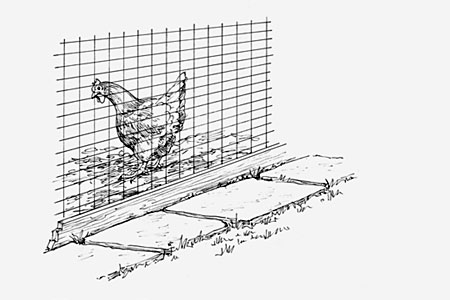
Keeping predators from digging into your chicken yard can be a challenge. How much effort and expense you wish to put into discouraging diggers depends a good deal on how long you expect your fence to last. If you are planning what you expect to be a lifetime fence, you might want to go all out. Below is a range of possibilities for keeping digging predators out of your chicken yard.
Bury the Fence
You could bury the bottom 12 inches or so of your chicken yard fence. This solution requires digging an extensive trench. It also requires using taller fencing, because part of it will be underground. One possibility is to use two lengths of fencing, one above the other and tightly fastened together.
Further, the fencing material must be super rust resistant. If you have doubts, coat the lower part of the fence with a rust-resistant paint or an impermeable compound such as roofing tar.
Concrete Footer
You could build your fence on top of a 12-inch deep concrete footer. It’s time-consuming and expensive, but it won’t rust and is permanent.
Like the first option, a concrete footer requires digging a trench around the run. Then build a form to shape the concrete and place reinforcement bars before pouring the concrete.
Paving Stones
Using large flat stones or concrete patio pavers is not as expensive and entails less work. Lay the pavers around the outside of your fence (as illustrated). Diggers must then start digging farther away from the fence line and may give up before they get through.
Apron Fence
This option is also known as a skirt fence, beagle net, or L footer. It consists of a wire mesh barrier at least 12 inches wide, securely attached at a right angle along the outside bottom of the fence. Since diggers normally start at the base of a fence, the apron is designed to stop them.
Commonly recommended for apron fencing is hexagonal netting (also known as chicken wire). But it does not hold up nearly as well as a sturdier mesh such as hardware cloth. Mesh openings of 2 to 3 inches will keep out most diggers. Exceptions are rodents and weasels, for which you will need half-inch or quarter-inch mesh.
The apron needs a good rust-resistant coating. Even galvanized wire begins to rust almost immediately upon contact with moist soil.
Typically the apron is buried under a foot of soil. But you can lay it on bare soil and cover it with sod, or even spread it right on top of the ground.
In the latter case, raccoons and other clever wildlife may lift the apron and dig underneath. To prevent that, and to facilitate mowing along the fenceline, securely anchor the apron with landscape staples. They are available at many farm stores and garden suppliers.
Don’t Forget the Coop
If your chicken coop has a dirt floor, you can keep digging predators out in much the same ways. This time, create your digger security around the coop walls.
Alternatively, you could line the entire floor with hardware cloth. Be sure to secure it tightly to the bottom of the coop walls, and cover it with compacted soil before adding coop litter.
And that’s today’s news from the Cackle Coop.
Gail Damerow authored several books about keeping poultry, many of them available from the Cackle Bookstore. Illustration from What’s Killing My Chickens?

